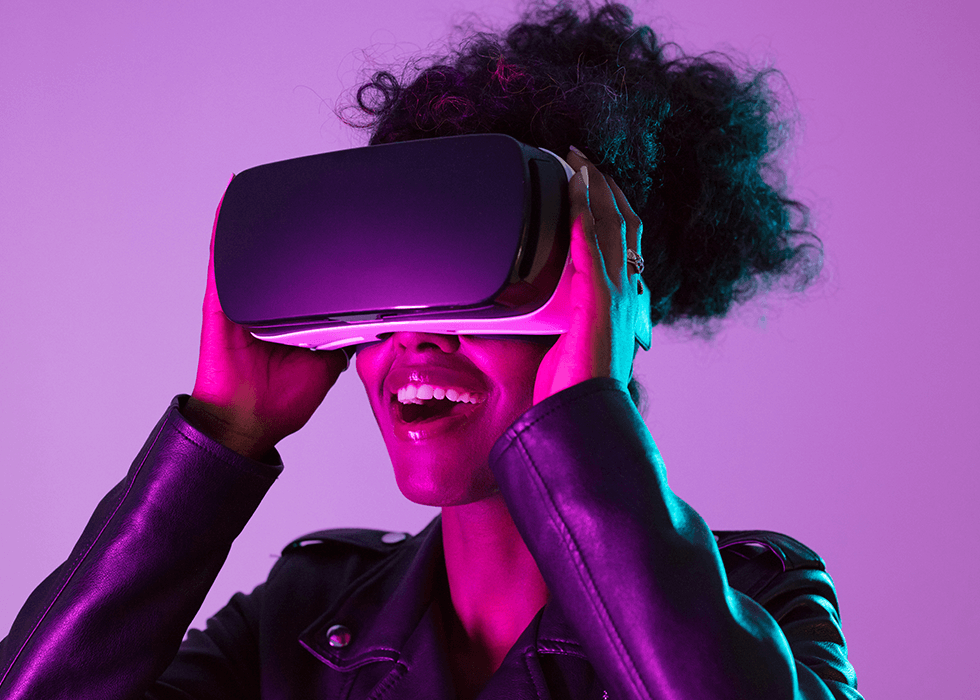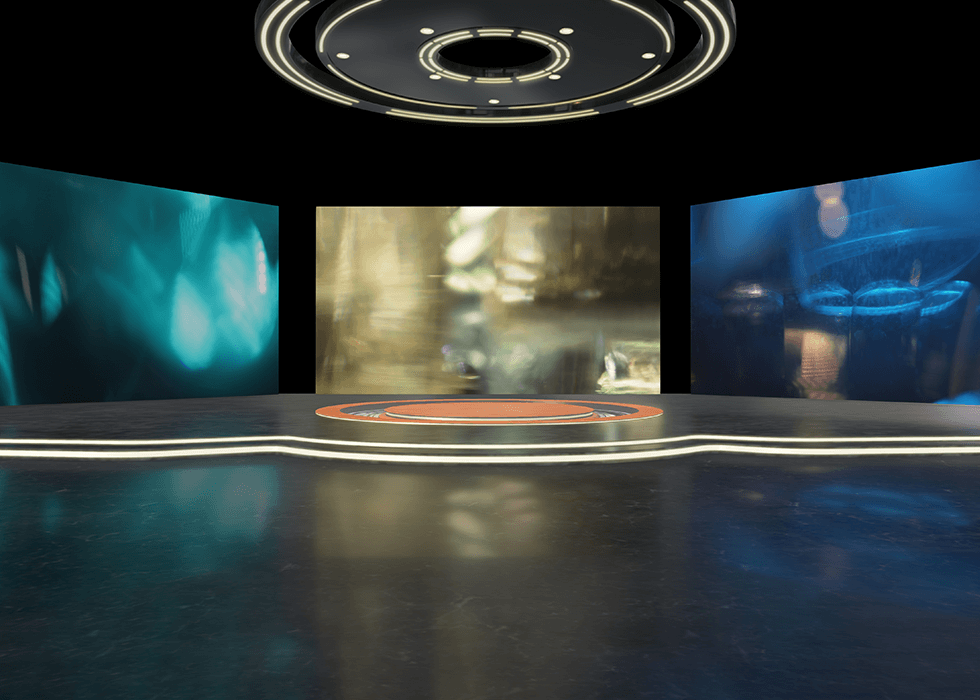
What is Immersive Technology?
Imagine not just watching a baseball game on a screen, but stepping right into the batter’s box or learning a new skill not by reading, but by practicing it in a lifelike digital space. That’s the promise of immersive technology, and it’s already changing how we work, play, and learn, bringing us directly into the action. From virtual reality (VR) and augmented reality (AR) to mixed reality (MR) and 360-degree experiences, it’s redefining how we connect, create, and engage.
Definition of Immersive Technology
Immersive technology fuses the digital and physical worlds, making you feel like you’re part of the action. It doesn’t just present content you view or scroll through. It pulls you into it, so you’re actively moving, reacting, and exploring. You might find yourself dodging virtual obstacles, rearranging your living room furniture, or swimming with turtles off the coast of the Galapagos. In the world of immersive technology, you’re not just observing—you’re constantly interacting.
Types of Immersive Technology
Traditional digital experiences keep you at arm’s length—you scroll, click, and watch from the outside. But with immersive technology, you step inside the action. Whether it’s AR, VR, MR, or 360-degree experiences, each offers a different way to engage your senses and reshape how you interact with the world to create powerful experiences that feel immediate, personal, and real.
1. VR
Virtual Reality places you inside a completely digital world, typically through a headset that blocks out your surroundings. This immersive experience is often enhanced with equipment like hand controllers and motion tracking software. Popular VR systems include Meta Quest, PlayStation VR, Valve Index, HTC Vive Pro, Bigscreen Beyond, and Pico.
Applications:
VR is widely used in gaming, but its reach extends into professional fields such as flight simulation, warehouse training, education, healthcare, architectural design, and more. It allows users to explore and interact with virtual environments, making it ideal for skill-building, testing scenarios, and enhancing learning experiences.
2. AR
Where AR enhances your existing surroundings, VR fully replaces them. It lets you enter a completely digital environment, typically through a headset that blocks out the physical world. The experience is often deepened with equipment like hand controllers, motion sensors, haptic gloves, and even treadmills or full-body tracking suits—all designed to heighten the sense of presence and interaction. Popular VR systems include Meta Quest, PlayStation VR, Valve Index, HTC Vive Pro, Bigscreen Beyond, and Pico.
Applications:
AR is used in gaming, in retail applications, letting you try on clothes or preview furniture, in education, in the form of animated textbooks and learning aids, in healthcare, in surgical overlays and diagnostic tools, and in commercial applications, such as field service repairs and installation guides. AR enhances real-world tasks with digital information and interactive features.
3. MR
Mixed Reality combines aspects of AR and VR, allowing digital and real-world elements to interact in real time. In MR environments, virtual objects respond to your environment and movements, creating an integrated blend of physical and digital. MR relies on advanced headsets, high-powered GPUs, and tools like motion sensors or haptic gloves to deliver this level of interactivity. MR is ideal for applications like simulation, design, training, and remote collaboration.
Applications:
MR is used in 3D product design, collaborative engineering, and immersive virtual walkthroughs. Users can interact with holograms or digital models that are tied to real-world spaces. In industries like manufacturing, architecture, and healthcare, MR enhances planning, prototyping, training, and diagnostics—bringing real-time context and precision to complex enterprise-level tasks.
4. 360-Degree Videos and Experiences
Offering a panoramic view in every direction, this video format places you at the center of the scene without letting you move or interact. While less immersive than VR, it delivers a strong sense of presence. The videos are captured with specialized cameras that are ideal for virtual tours, live events, documentaries, and immersive storytelling. You can view the content on standard screens or through a VR headset for an enhanced sense of immersion.
Applications:
360-degree content is used in virtual real estate tours, tourism previews, immersive journalism, and educational storytelling. Platforms like YouTube and The New York Times Daily 360 feature this type of media to place viewers at the center of the action—no headset required, just a screen that lets you drag and explore.
Technological Components of Immersive Technology
“Behind the scenes,” so to speak, immersive experiences rely on hardware and software, including the user interface (UI), all working seamlessly together to make magic happen.
- Hardware: This includes VR headsets, AR glasses, cameras, motion sensors, and spatial audio systems. These devices track your movements and deliver visuals and sounds that respond in real time.
- Software: Consists of development platforms like Unity and Unreal Engine, plus the middleware, APIs, and cloud services that support seamless performance across devices.
- UI: The UI is an essential component that can make-or-break the experience. Beyond traditional menu systems, immersive UIs include:
- Gesture-Based Interfaces – Your hand movements are tracked by cameras or sensors. You might pinch your fingers together to select a virtual object or swipe your hand in the air to navigate through menu options.
- Gaze-Based Controls – Your eye movement controls the experience, letting you select items or trigger actions simply by looking at them.
- Voice Commands – Integrated voice recognition lets you interact hands-free, whether you’re issuing commands, asking questions, or navigating environments.
- Haptic Interfaces – These add a tactile layer to virtual interaction. Gloves, vests, or haptic controllers let you “feel” virtual textures, impacts, or pressure.
- Spatial UI Elements – Instead of flat menus, buttons and controls in 3D space around you respond dynamically to your position and movement.
Together, the hardware, software, and UI create the seamless, magical experiences that define this cutting-edge technology.
Applications of Immersive Technology
Immersive technology has many applications and is driving significant value across virtually every industry, from entertainment and education to health care and business and commerce.
1. Entertainment and Media
While the gaming industry led the way in adopting immersive media, its use has since expanded into many other areas. Today, you can attend virtual reality concerts where you pick your viewing location, watch music videos that shift based on your movements, and experience films with branching storylines you control. News organizations are using 360-degree video to place viewers at the heart of the story, offering a more powerful, firsthand perspective.
With immersive technology, audiences don’t just watch, they engage. Whether it’s a virtual front row seat at a festival or exploring walking through the ruins in ancient Rome, immersive technology is boosting emotional connections and vibrant experiences.
2. Education and Training
Immersive technology enables students of all ages and abilities to step inside molecular structures, explore the solar system, and walk through historical events as if they’re present. Medical students can practice techniques, make mistakes safely, and build confidence before working with real patients. Firefighters can train in high-pressure scenarios without actual danger. Pilots can log virtual hours before ever touching a real cockpit. The applications are endless.
Experiential learning makes abstract concepts more concrete and memorable. Medical students can perform practice surgeries in realistic digital spaces, learning techniques.
3. Healthcare
In hospitals and clinics, the technology is transforming patient care. It’s being used for pain management, helping distract patients with calming, immersive environments during painful procedures like dressing changes. In mental health care, it's being used for treating phobias and PTSD. In rehab programs, it helps stroke recovery and improves mobility in a motivating, interactive way. In surgical centers, physicians are using 3D renderings of patient-specific anatomy to plan complex procedures with greater precision.
Immersive technology in healthcare is revolutionizing patient care, offering new opportunities for enhanced treatment, recovery, and precision treatments.
4. Business and Industry
Immersive technology is changing how teams design, build, and collaborate. Engineers can explore 3D CAD models of buildings or systems before construction, spotting issues and making real-time adjustments. Remote teams can brainstorm in shared virtual spaces, while product demos offer clients hands-on experiences. Corporate training is also more efficient, allowing new hires to practice tasks in virtual environments before real-world application.
In short, immersive tech is transforming various types of workflows across all sectors of the economy, improving collaboration, and driving innovation and operational efficiency.
5. Retail and Marketing
Shopping is becoming more interactive and enjoyable. Shoppers can try on products like glasses, clothing, and makeup virtually, or visit virtual showrooms where they can place furniture in their homes on their phones and laptops. Immersive tools personalize shopping, increase confidence, and reduce returns. In marketing circles, the applications are equally diverse, spanning interactive billboards, VR games, holographic product launches, and more.
These immersive marketing and sales initiatives foster deeper brand connections by turning consumers into active participants and buyers.
Challenges and Limitations of Immersive Technology
As dynamic and far-reaching as immersive technology is, it comes with a few speed bumps that you should keep in mind, from the high cost of components and low latency of systems to privacy issues and accessibility challenges:
- Expensive Hardware: Top-tier gear can run into the thousands, making large-scale rollouts tough for many organizations.
- Poor Performance: Lag, latency, and low resolution quickly break immersion and frustrate users.
- Privacy and Ethics Concerns: Tracking eye movement, hand gestures, and spatial behavior raises serious concerns about how data is collected, stored, and used.
- Accessibility Issues: Not everyone has the physical ability or financial resources to engage with immersive technology, leaving out vast segments of the population.
These challenges are significant, especially in application settings where reliability, equity, and compliance are critical. Overcoming these hurdles as the technology matures requires collaborative efforts toward standardization, inclusive design, the development of cost-effective hardware, and the ironing out of privacy concerns.
Future of Immersive Technology
Immersive technology is advancing rapidly with lightweight, wireless headsets, real-time AI, and ultra-fast 5G+ connections. Cloud-enabled visuals are apt to enhance experiences across industries, making the experiences more interactive and dynamic. As immersive technology becomes more mainstream and affordable, it’s poised to transform everything from operating rooms to classrooms and job sites, creating new opportunities for innovation and efficiency.
Immersive Technology: The Takeaway
We’re only now just scratching the surface of the potential of immersive technology to transform industries, enhance personal experiences, and redefine how we engage with the world around us. As the technology evolves, it will open up new avenues for storytelling, problem-solving, and creative expression. For AV professionals, embracing these innovations now is the key to staying ahead of the curve and delivering unforgettable, cutting-edge experiences for clients.
Image credit: Getty Images/izusek








